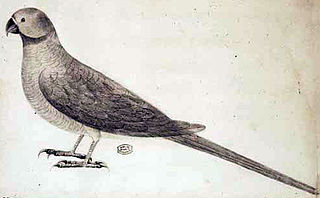
Newton's parakeet, also known as the Rodrigues parakeet or Rodrigues ring-necked parakeet, is an extinct species of parrot that was endemic to the Mascarene island of Rodrigues in the western Indian Ocean. Several of its features diverged from related species, indicating long-term isolation on Rodrigues and subsequent adaptation. The rose-ringed parakeet of the same genus is a close relative and probable ancestor. Newton's parakeet may itself have been ancestral to the endemic parakeets of nearby Mauritius and Réunion.

Ariadne merione, the common castor, is an orange butterfly with brown lines whose larvae feed almost exclusively on castor. It is similar in appearance to Ariadne ariadne, the angled castor.
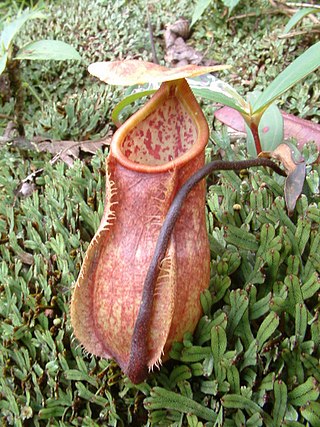
Nepenthes papuana is a tropical pitcher plant endemic to New Guinea. The specific epithet papuana is derived from Papua, an alternative name for the island.
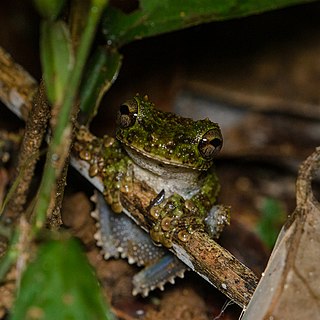
Osteocephalus cabrerai is a species of frog in the family Hylidae. It is found in the Amazon Basin in Brazil (Manaus), northeastern Peru, Ecuador, Colombia, Guyana, and French Guiana, possibly wider. Some earlier records refer to Osteocephalus buckleyi.
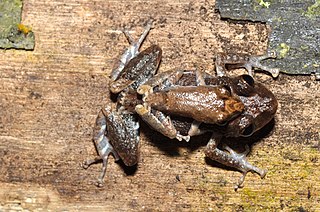
Pristimantis altamazonicus is a species of frog in the family Strabomantidae. As currently defined, it is known from the Amazon rainforest of Colombia, Ecuador, and Peru.

The moustached kingfisher, also called Bougainville moustached kingfisher, is a species of bird in the family Alcedinidae. It is endemic to Bougainville Island in Papua New Guinea. An estimated 250–1,000 mature individuals are left.

The small-toothed fruit bat or small-toothed Flying fox is a species of megabat in the family Pteropodidae. It is the only species within the genus Neopteryx. It is endemic to central Indonesia. It is known only from two localities on Sulawesi island. Its natural habitat is subtropical and tropical dry forests.
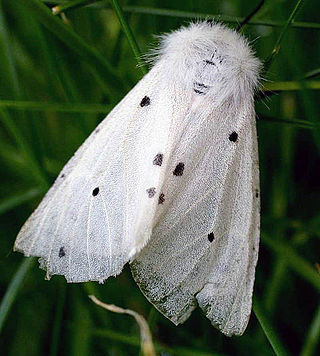
Diaphora mendica, the muslin moth, is a moth of the family Erebidae. It is found in the Palearctic realm east to Lake Baikal.

Lithosia quadra, the four-spotted footman, is a moth of the family Erebidae. It is found in southern and central Europe then east across the Palearctic to the Amur River and Japan. It is also found in the south of Great Britain and Scandinavia.

Calliteara pudibunda, the pale tussock, is a moth of the family Erebidae. The Dutch common name for the moth (Meriansborstel) comes from the butterfly and insect painter Maria Sibylla Merian. The species was first described by Carl Linnaeus in his 1758 10th edition of Systema Naturae. It is found in Asia and Europe.
Bokermannohyla itapoty is a species of frogs in the family Hylidae. It is endemic to the state of Bahia in northeastern Brazil. It is closely related to Bokermannohyla alvarengai. The specific name itapoty refers to the dorsal coloration that gives this frog a lichen-like resemblance. The name is derived from the Tupi–Guarani words itá (="rock") and poty, meaning lichen or moss.

Brachycephalus alipioi is a species of frogs in the family Brachycephalidae, genus Brachycephalus. It is endemic to the Atlantic rainforest of the Espírito Santo state of southeastern Brazil. They can be found walking slowly on the leaf litter or on the forest floor. Mites and spiders were found in the stomachs of two of the specimen, although their diet may be more abundant. All specimens were diurnal.

Ariadne is a genus of nymphalid butterflies, commonly called castors, found from Sub-Saharan Africa to South-East Asia. It was erected by Thomas Horsfield in 1829. The genus was named after Ariadne the daughter of Minos, king of Crete.
Peripatus evelinae is a species of velvet worm in the Peripatidae family. The male of this species has 33 pairs of legs; females have 35 or 36 leg pairs. This species has more legs than any other species of Peripatus; the females of the other species have at most 34 leg pairs, and the males have at most 32. The original description of P. evelinae was based on two specimens and reported females with 32 and 34 leg pairs, but another examination of these specimens revealed a male with 33 leg pairs and a female with 35 leg pairs instead as well as numerous embryos, including females with 35 and 36 leg pairs. The male specimen is 44 mm long; the female is 65 mm long. The type locality is in Goiás, Brazil.

Peripatus juanensis is a species of velvet worm in the Peripatidae family discovered in Puerto Rico in 1900. As of 2018, it is the only velvet worm found in Puerto Rico. Females of this species have 31 or 32 pairs of legs; males have 27.
Paraperipatus lorentzi is a species of velvet worm in the Peripatopsidae family. This species is a dark green-blue. Females of this species have 22 to 28 pairs of legs; males have 21 or 22 pairs of legs. Whereas the original description of this species records 19 mm as the length of a male specimen, females range from 33 mm to 60 mm in length. The type locality is in Western New Guinea, Indonesia. The validity of this species is uncertain: Although some authorities deem P. lorentzi to be a junior synonym of P. papuensis, a similar species also found in Western New Guinea, others recognize them as two separate species.
Atelopus ardila is a species of frog in the family Bufonidae. It has not been seen since 1992, and is believed to be possibly extinct.
Opisthopatus baziya is a species of velvet worm in the family Peripatopsidae. This species has 16 or 17 pairs of legs in both sexes and ranges from rose pink to dark pink. Male specimens range from 17 mm to 31 mm in length; female specimens range from 13 mm to 26 mm in length. This species is endemic to the forests at Baziya in the Eastern Cape province of South Africa.
Osmia ariadne is a species of mason bee of the family Megachilidae. Female specimens were used to describe the species. Its hue is black, and females measure around 11 to 12 mm. It is distributed throughout Greece and Turkey.

Ariadne celebensis, the Celebes castor, is a butterfly in the family Nymphalidae. It is found in Sulawesi.














